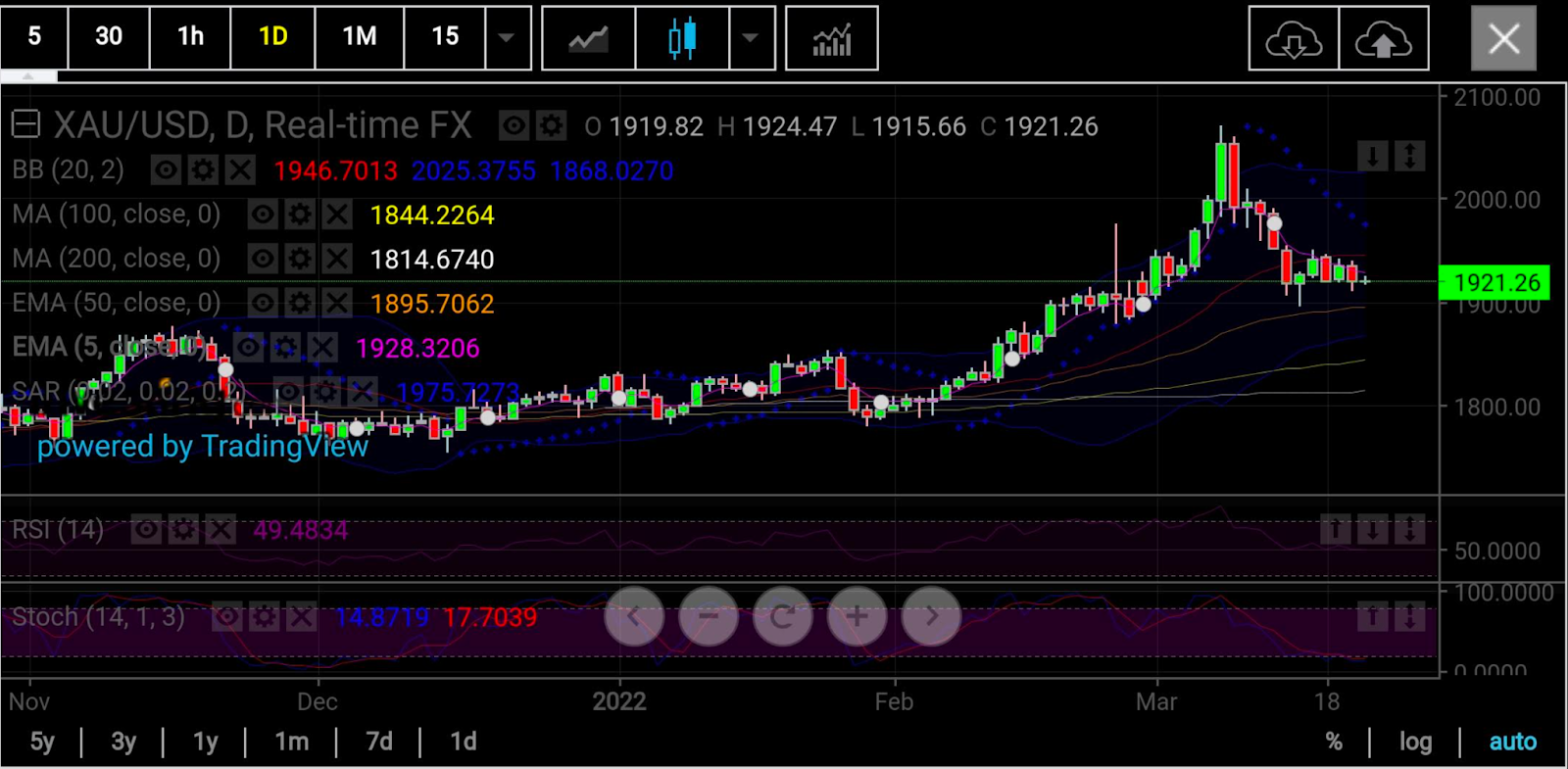Gold longs got the vindication they wanted when the yellow metal finally hit $2,000 an ounce two weeks ago, ending their 19-month long wait to recapture the level last seen during the COVID-19 crisis.
Now, they might have to wait another two months, or possibly longer, for bullion to have another shot at that level.
This is based on the super hawkish mood of Federal Reserve bankers—from Chairman Jerome Powell down—in plotting the most aggressive ramp-up in US interest rates in two decades to fight inflation, which is growing at its fastest in 40 years.
And gold has been slowly responding to the Fed’s ever-hawkish stance, falling from a Mar. 8 peak of $2,078.80 on New York’s COMEX futures to below $1,920 in Wednesday’s Asian trading window.
Anyone doubting the dark clouds gathering over the yellow metal just need to look at the US 10-year Treasury note, which has been showing renewed vigor in recent days, aiming for highs last visited in May 2019. The opposite paths taken by benchmark US Treasury yields and gold is legendary.
Charts courtesy of skcharting.com
The 10-year note briefly tanked after the Fed’s first pandemic-era rate hike of just 25 basis points a week ago. It stayed down until Powell suddenly switched gears this week on the central bank’s inflation-fighting thrust.
In a speech to the National Association for Business Economics in Washington on Monday, Powell erased words like “patient” and “nimble” from his policy vocabulary, and inserted terms like "expeditiously" and "more aggressively" instead to describe forthcoming rate hikes.
Central to the theme of Powell and his policy-making cadres at the central bank’s Federal Open Market Committee (FOMC) is a 50 basis point hike, which Goldman Sachs says could happen back-to-back at the May and June FOMC meetings. The committee is due to meet six times in all between now and the end of the year and Powell said there could be a rate hike each time it meets.

More interestingly, when asked at the Washington forum on what could dissuade the Fed from approving a 50 basis point hike next, he replied emphatically: “Nothing.”
It was a 180-degree reversal for the Fed Chair who, just two weeks ago, appeared genuinely concerned about the economy amid heightened worries from the fallout of the Russia-Ukraine war. The last time Powell did such policy U-turn was when he suddenly dropped “transitory” at the end of last year to describe inflation, after downplaying price pressures for months earlier.
It may not be surprising that the Fed Chair is finally coming to terms with the reality of price pressures.
The US economy grew 5.7% last year, growing at its fastest since 1984. But inflation, measured by the Consumer Price Index, grew at an even faster rate, expanding by 7% in 2021, its most since 1981. Since then, CPI has continued tearing through the roof, expanding 7.5% YoY in January and 7.9% YoY in February.
What’s really surprising, notes Craig Erlam, analyst at online trading platform OANDA, is the preparedness of investors for Fed rates to reach 2% by the end of the year.
“That's an incredible, aggressive tightening cycle and would mean at least one 50 basis point hike at a meeting, something we haven't seen in more than 20 years,” said Erlam.
And reflecting that investor resolve in the stock market, which rallied in five of the past six sessions, giving the S&P 500 a net gain of just over 4%, has been helped largely by rising bank stocks celebrating the higher interest rate regime.
With a super-hawkish Fed combined with a super-bull market, do gold prices—which typically thrive in an environment of economic and political fear—stand a chance?
So, where could gold go from here through April, and through May and June when the two 50 basis point hikes anticipated by Goldman Sachs are carried out?
The logical answer is $1,800, maybe even lower, and that’s not stretching it, says Sunil Kumar Dixit, chief technical strategist at skcharting.com.
Basing his call on the spot price of bullion, which at the time of writing stood at just under $1,919, Dixit said gold’s downward path was established after it was rejected at the $2,070 peak to slide for a third week in a row.
The persistent reluctance of gold longs to chase a bullish trend may largely be due to the potentially bearish double-top formation at $2,074 and $2,070 that was clearly visible on spot bullion’s monthly and weekly charts, he said.
“Breaking below $1895, gold can attempt to dig into $1,850-$1,825, the later being a confluence of the 50 Exponential Moving Average and the 100 Simple Moving Average on the weekly chart,” said Dixit.
The oversold stochastic reading of 14/17 on the daily chart can support a short-term bounce to $1,935-$1,955, and hold above that can lead to a recovery extending to $1,985-$2,010.
But if longs wish, they could also see the near-term gold correction as an opportunity to buy in at a meaningful discount—something that may not be possible if the fallout from the war in Ukraine and the ensuing geopolitical and economic impact proves bigger than any Fed rate hike.
In such a scenario, gold could entrench itself firmly in $2,000 territory from mid-June onwards to crack the August 2020 record highs of $2,121.70 on New York’s COMEX futures and $2,073.41 on spot gold.
“If gold digs deeper now into $1,825 and even $1,800, this may just be a last call to come on board, before the next big and huge bull run begins that has initial targets at $2,150 and $2,500 over the next two quarters,” said Dixit.
Disclaimer: Barani Krishnan uses a range of views outside his own to bring diversity to his analysis of any market. For neutrality, he sometimes presents contrarian views and market variables. He does not hold positions in the commodities and securities he writes about.
